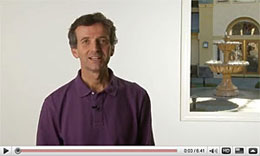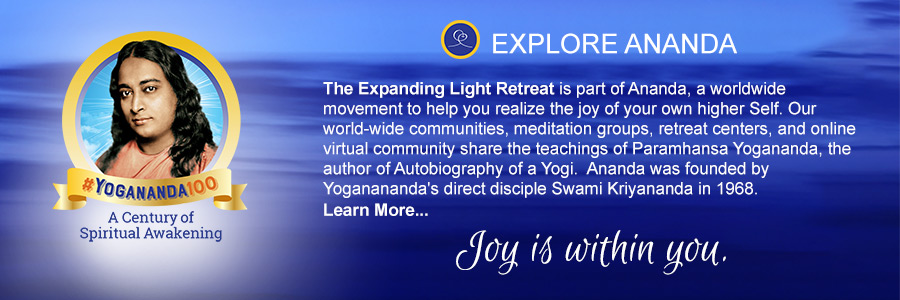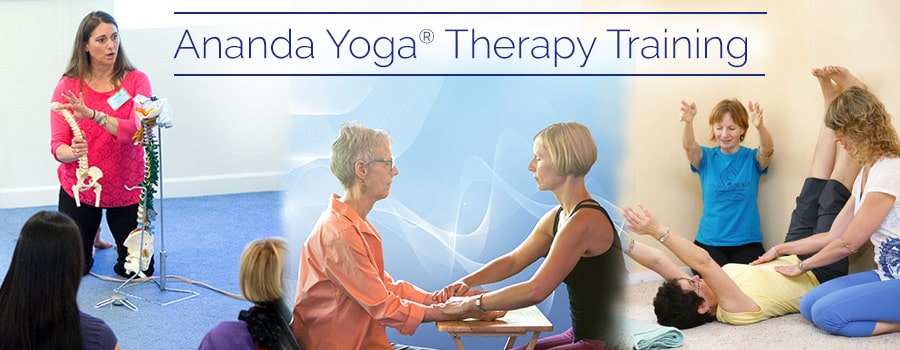SYLLABUS
The Essence of the Yoga Sutras
We are not currently accepting new students in the Ananda Yoga Therapy Training
Course Hours: Total: 38 (Residential)
Prerequisite
Graduate of Ananda Yoga Teacher Training (200-hour), or
Graduate of a Yoga Alliance approved 200-hour Yoga Teacher Training
Teaching Format
This is a 6-day course which includes a combination of lecture, discussion, and experiential advanced asana workshops.
Faculty: Ananda Ministers and Certified Meditation Teachers:
Nayaswami Pranaba Hansen, Kriyacharya, Certified 500 hr. Ananda Yoga Teacher
Nayaswami Parvati Hansen, Kriyacharya
Nayaswami Gyandev McCord, PhD, E-RYT 500, Director of Ananda Yoga, Kriyacharya
Nayaswami Mangala Loper-Powers, RN, MN, E-RYT 500, Ananda Yoga Therapist, C-IAYT
Maitri Jones, RN, BSN, E-RYT 500, Ananda Yoga Therapist, C-IAYT
Required Texts/Reading Materials
Kriyananda. Demystifying Patanjali : The Yoga Sutras (aphorisms). Nevada City: Crystal Clarity, 2013. (real the whole book)
Course Description
Patanjali, the great ancient exponent of yoga, described the stages of spiritual development for all seekers. These principles of yoga are based not on dogma, but on how we are made. This course explores these important subjects:
- Ashtanga Yoga
- Obstacles to Yoga
- Samadhi
- Attitude
- Making Patanjali practical
- How to teach advanced asanas
- How to apply the teachings of the Sutras and especially the yamas and niyamas to the practice of yoga therapy
Learning Objectives
At the end of the course, students will know:
- How to use the Eightfold Path to enhance success for you and your clients on all levels including spiritually and in yoga therapy.
- What holds people back spiritually, and how to overcome it in yourself and how to help your clients.
- What is this state of Samadhi or Oneness, and how can you and your clients move toward an actual experience of it.
- How to help clients develop the attitudes essential for success on all levels of life.
- How to help clients integrate the essence of yoga into daily life.
- The essence of the yamas and niyamas and how they apply to an individual’s ability to achieve wellness on all levels.
- How a yoga therapist applies the above knowledge to serving clients’ best interests.
Subject Matter/IAYT Competencies Covered
Section 1. Yoga Foundations
Category 1.1. Yoga Teachings and Philosophy
1.1.1. Familiarity with the evolution of the teachings and philosophy of the yoga tradition and its relevance and application to yoga therapy, including teachings from Vedic and post-Vedic periods, Samkhya,Yoga,Tantra, and Ayurveda.
Examples of concepts and models from the above teachings and philosophy relevant to yoga therapy, include but are not limited to,
a. tanmatra/bhuta/indriya (subtle element/gross elements/senses);
b. purusha/prakrti (consciousness/material world);
c. pancamaya kosha (dimensions of the human system);
d. guna (fundamental forces of nature); and
e. duhkha (suffering/discomfort).
Category 1.2. Yoga and the Mind
1.2.1. Knowledge of yoga perspectives on the structure, states, functioning, and conditions of the mind, including, but not limited to,
1.2.1.1. drashtr (seer), drshya (seen);
1.2.1.2. antahkarana citta (consciousness), buddhi (intellect), ahamkara (ego), manas (mind);
1.2.1.3. citta vrtti (activities of the mind), citta parinama (structural changes in the mind), vyutthana/nirodha (mind's potential for distraction and focus);
1.2.1.4. artha (cognition), bhava (mood), svabhava (inborn nature), vasana (residue of experience), samskara (conditioned pattern of thinking and behavior); and
1.2.1.5. states of mind: mudha (stupefied/dull), kshipta (disturbed), vikshipta (alternating between distraction and focus), ekagrata (one-pointed), nirodha (focus enveloped/held/ restrained), vaishvanara (waking), taijasa (dream), prajña (deep sleep), turiya (beyond).
1.2.2. Knowledge of yoga perspectives on distracted/disturbed conditions of mind and their expressions as expressed in such texts as the Yoga Sutras, the Bhagavad Gita, and other texts, including but not limited to,
1.2.2.1. klesha (affliction);
1.2.2.2. lobha, krodha, and moha (greed, anger, attachment);
1.2.2.3. duhkha and daurmanasya (suffering/discomfort and negative attitude/thinking), sarupyam (identification with the contents of the mind or seer taking the same form as the mind); and
1.2.2.4. antaraya (obstacles to progress in yoga).
Section 3. Yoga Therapy Tools and Therapeutic Skills
Category 3.1. Yoga Practices
3.1.1. In-depth knowledge of the application of yama and niyama.
3.1.2. In-depth knowledge of the range of yoga practices and their potential therapeutic effects for common conditions Practices may include, but are not limited to,
3.1.2.1. asana (postures);
3.1.2.2. pranayama (regulated breathing);
3.1.2.3. meditation and relaxation techniques such as bhavana (visualization), mantra (recitation), and ritualized activities such as nyasa and mudra; and
3.1.3. In-depth knowledge of contraindications of yoga practices for specific conditions and circumstances.
Category 3.3 Principles and Skills for Educating Clients/Students
3.3.2. In-depth knowledge of and demonstrated ability to transmit the value of self-awareness and self- responsibility throughout the therapeutic process.
Section 5. Professional Practice
Category 5.1. Ethical Principles
5.1.1. In-depth knowledge of yoga practices and methods for self-inquiry related to establishing, practicing, and maintaining ethical principles.
Course Completion Requirements
Students have demonstrated understanding of course learning objectives by their attendance at all lectures, participation in all discussions and asana workshops. Completion of required book reading.
Ananda Yoga Therapy Training
- Overview
- Flow Chart of Ananda Yoga® Therapy Training Courses
- Course Syllabi
- Tuition Costs
- Ananda Yoga® Therapy Training Courses Scheduled
- Frequent Questions
- Instructors
- Apply for Level 1
- Student Handbook with Costs
- Bridge to Ananda Yoga
Upcoming Courses in date order
- Bhagavad Gita Retreat
- The Essence of the Yoga Sutras According to Paramhansa Yogananda
- Ananda Meditation® Teacher Training - In Person
- Advanced Pranayama
- Ananda Yoga® Assistantship
- Ananda Yoga® Therapy Training: Principles
- Ananda Yoga® Advanced Training: Therapeutic Yoga for Seniors and Bone Strength
- Restorative Ananda Yoga® Teacher Training - In Person
- Ananda Yoga® Therapy Training: Musculoskeletal–1
- Ananda Yoga® Therapy Training Online: Ayurveda
- Ananda Yoga® Therapy Training Online: Health Challenges–1
- Ananda Meditation® Solutions
- Ananda Spiritual Counseling® Training - In Person
- Ananda Yoga® Therapy Training: Musculoskeletal–2
- Ananda Yoga® Therapy Training Online: Health Challenges–2
- Ananda Yoga® Therapy Training: Psychology and Mental Health
- Ananda Yoga® Therapy Training: Holistic Health Therapist Training
Nursing CEU Eligible: details coming

How to Choose a
Yoga Teacher Training Program

“My 4 weeks of Ananda Yoga Teacher Training was one of the most fulfilling and spiritually transforming periods in my life. All of the faculty, along with the entire Ananda community, were very supportive and nurturing.” – R. F., Lake Bluff, IL.

Testimonial for the Ananda Yoga Therapy Training Program
“The program is all embracing ˜ asana, ayurveda, chakras, special health issues touching on body, mind, and spirit. The instructors were wonderful, knowledgeable, supportive, and enthusiastic.” – T.C., CA.







The yoga therapy components of these courses are based on our accreditation by IAYT, not derived from our status as an RYS with Yoga Alliance Registry.


CONNECT
14618 Tyler Foote Rd
Nevada City, California 95959
Toll free 800-346-5350
Outside US 530-478-7518
LEARN MORE
SUBSCRIBE
Receive uplifting emails with inspirational content and news about our retreat programs, travels, and trainings.
















